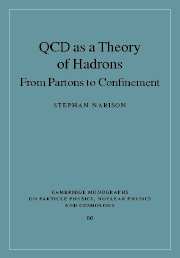Book contents
- Frontmatter
- Contents
- About Stephan Narison
- Outline of the book
- Preface
- Acknowledgements
- Part I General introduction
- Part II QCD gauge theory
- Part III MS-bar scheme for QCD and QED
- Part IV Deep inelastic scatterings at hadron colliders
- Part V Hard processes in e+e– collisions
- Part VI Summary of QCD tests and αs measurements
- Part VII Power corrections in QCD
- Part VIII QCD two-point functions
- Part IX QCD non-perturbative methods
- 40 Introduction
- 41 Lattice gauge theory
- 42 Chiral perturbation theory
- 43 Models of the QCD effective action
- 44 Heavy quark effective theory
- 45 Potential approaches to quarkonia
- 46 On monopole and confinement
- Part X QCD spectral sum rules
- Part XI Appendices
- Bibliography
- Index
44 - Heavy quark effective theory
from Part IX - QCD non-perturbative methods
- Frontmatter
- Contents
- About Stephan Narison
- Outline of the book
- Preface
- Acknowledgements
- Part I General introduction
- Part II QCD gauge theory
- Part III MS-bar scheme for QCD and QED
- Part IV Deep inelastic scatterings at hadron colliders
- Part V Hard processes in e+e– collisions
- Part VI Summary of QCD tests and αs measurements
- Part VII Power corrections in QCD
- Part VIII QCD two-point functions
- Part IX QCD non-perturbative methods
- 40 Introduction
- 41 Lattice gauge theory
- 42 Chiral perturbation theory
- 43 Models of the QCD effective action
- 44 Heavy quark effective theory
- 45 Potential approaches to quarkonia
- 46 On monopole and confinement
- Part X QCD spectral sum rules
- Part XI Appendices
- Bibliography
- Index
Summary
Introduction
Over a decade, a lot of experimental informations on heavy-quark decays and masses have been obtained from e+e– and hadron collider experiments. These have led to a detailed knowledge of the flavour sector of the standard model and to the discoveries of the B0 – 0 mixing, rare decays induced by penguin operators, … The experimental progress in the heavy flavour physics has been accompanied by some theoretical progress. Among other approaches, the discovery of the heavy-quark symmetry has led to the development of the heavy quark effective theory (HQET), which provides a systematic analysis of the properties of a hadron containing a heavy quark in terms of an expansion of the inverse of the heavy quark mass. Detailed discussions and references to the original works can be found in different reviews and lectures (see e.g. [545]).
Heavy-quark symmetry
When the mass of the heavy quark is much larger than the QCD scale ΛQCD, the QCD running coupling αs(mQ) is small, implying that at this scale of the order of the Compton wavelength λQ ∼ 1/mQ, one can safely use perturbative QCD for describing the hadrons. In this case the Q-bound states with the size λQ/αs(mQ) ≪ Rhad ∼ 1 fermi are like the hydrogen atom.
- Type
- Chapter
- Information
- QCD as a Theory of HadronsFrom Partons to Confinement, pp. 442 - 463Publisher: Cambridge University PressPrint publication year: 2004



